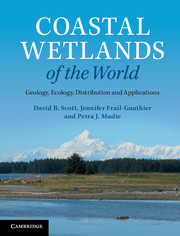Book contents
- Frontmatter
- Contents
- Preface
- List of acronyms and abbreviations
- 1 Introduction: what is covered in this coastal wetlands book?
- 2 Physical aspects: geological, oceanic and climatic conditions
- 3 Zonations and plants: development, stressors and adaptations
- 4 Animals in coastal wetlands: zonation, adaptations and energy flow
- 5 Human intervention causing coastal problems
- 6 Coastal wetlands worldwide: climatic zonation, ecosystems and biogeography
- 7 Examples of North American salt marshes and coastal wetlands
- 8 Examples of South American coastal wetlands
- 9 Africa: selected marsh and mangrove areas
- 10 Europe and Asia: a view of what remains
- 11 Australasia: wetlands of Australia and New Zealand
- 12 Applications in geological monitoring: paleoseismology and paleoclimatology
- 13 Applications in conservation of plant biodiversity and agriculture
- 14 Using mesocosms as a way to study coastal wetlands
- 15 Conclusions and future directions
- References
- Index
- Plate section
15 - Conclusions and future directions
Published online by Cambridge University Press: 05 July 2014
- Frontmatter
- Contents
- Preface
- List of acronyms and abbreviations
- 1 Introduction: what is covered in this coastal wetlands book?
- 2 Physical aspects: geological, oceanic and climatic conditions
- 3 Zonations and plants: development, stressors and adaptations
- 4 Animals in coastal wetlands: zonation, adaptations and energy flow
- 5 Human intervention causing coastal problems
- 6 Coastal wetlands worldwide: climatic zonation, ecosystems and biogeography
- 7 Examples of North American salt marshes and coastal wetlands
- 8 Examples of South American coastal wetlands
- 9 Africa: selected marsh and mangrove areas
- 10 Europe and Asia: a view of what remains
- 11 Australasia: wetlands of Australia and New Zealand
- 12 Applications in geological monitoring: paleoseismology and paleoclimatology
- 13 Applications in conservation of plant biodiversity and agriculture
- 14 Using mesocosms as a way to study coastal wetlands
- 15 Conclusions and future directions
- References
- Index
- Plate section
Summary
In this book, we have shown where and how tidal salt marshes form worldwide and the kinds of conditions required for coastal marsh formation. There are many different examples of the dangers to survival of the remaining coastal marsh formations in light of the sensitivity of these environments to anthropogenic and natural forces of climatic and oceanographic change. We discussed the different marsh vegetation types, and their zonations, in the world’s main climatic regions. Also included were lists of the kinds of animals living in these environments, many of which are now endangered species because of worldwide coastal wetland destruction or pollution. Ecologically, we discussed main patterns of energy flow, feeding relationships and the extraordinarily high production in coastal wetlands. Study of both the current biology and ecology of salt marshes and mangroves is extremely important in fully understanding various global paleoenvironments, and therefore possible future scenarios within these vital systems. For example, we have outlined the impacts expected to follow the unprecedented recent changes in Arctic sea ice and wetlands and we have shown ways in which we can unravel the natural history and speeds of past coastal wetland changes using fossil pollen combined with microfossils that record the salinity and elevation of the marshlands. These geological tools can also be used to forecast the future of the wetlands, including the likelihood of megaquake occurrences, as indicated by ‘silent earthquake’ traces. Experiments with marsh mesocosms provide an important tool for further understanding the complex interactions between salt marsh plants, animals and their intertidal environment. Examples are also given of practical applications in agriculture and industry that have arisen from research on some unique products offered by salt marsh and mangrove plants – and the importance of preserving marshland biodiversity as a reservoir of salt-tolerant ionomes and genomes for the new ‘Green Revolution’ and to meet global water conservation targets on which human survival depends.
- Type
- Chapter
- Information
- Coastal Wetlands of the WorldGeology, Ecology, Distribution and Applications, pp. 297 - 301Publisher: Cambridge University PressPrint publication year: 2014



